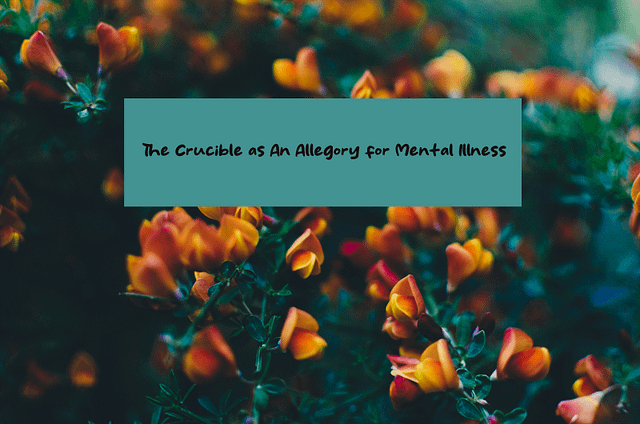
When I was in high school, I read Arthur Miller’s “The Crucible”. The play chronicles the path of destruction set by a group of teens. You know, teenager things.
While most of my research has led to its political connections, the play reflects on the relationship between mental illness and an ill-prepared community. To rephrase, the play is an allegory for mental illness in modern-day Western civilizations.
Much like mental illness, witchcraft is not something her community can deal with. They do not know what it looks like With a lack of dialogue from those dealing with witchcraft directly, the community can’t find the actions necessary to address it.
In addition, it is not an illness they can trace. Not only that, but the community does not know how to deal with Abigail’s accusations. This is similar to how mental illness puzzles many communities. By examining these ideas, I am going to explain how The Crucible is a helpful mental illness allegory. It’s a modern take on how we need to understand mental illness.
The History of Hysteria: Contextualizing Witchcraft To Mental Illness
Throughout the play, Miller suggests that Abigail and her friends commit crimes. They appear to be part of a tragic chain of events. Their choice to dance in the forest leads to many deaths. Because it is not socially acceptable, the girls must address an angry community. As such, the play revolves around hysteria, which is a societal response to women misbehaving.
Ada McVean notes that “Hysteria was basically the medical explanation for ‘everything that men found mysterious or unmanageable in women’” Because men dominated the medical field (and were mostly all that scientific studies were based on), women’s hysteria diagnosis was common.
Cleverly, Arthur Miller comments on human nature’s tendency to lean into paranoia. Doing so makes the play relevant beyond politics. As a mental illness allegory, the play highlights how society hides mental illness.
If a person were to find themselves on a path to get a diagnosis, they face isolation and judgment. To clarify, society trivializes some mental illnesses compared to physical illnesses (Lockett). As a result, this makes it scarier to share experiences without negative consequences.
“I cannot sleep for dreaming; I cannot dream but I wake and walk about the house as though I'd find you comin' through the door.” -Abigail Williams in The Crucible
Witchcraft as a Mental Illness Allegory
Due to its silent nature, it’s difficult for communities to understand mental illness. People can hide it. This is precisely the point Arthur Miller points to. The judge in the play says “But witchcraft is i[…] by its nature an invisible crime”.
Furthermore, in witchcraft, Miller creates an illness with no symptoms. Anyone could get it. For this reason, the panic rises throughout the play. For example, Miller writes, “Mrs. Putnam: Her soul, her soul seems flown away. She sleeps and yet she walks…” How do I track where my soul goes?
Thus, witchcraft is not only metaphysical. It is also incurable. In other words, to gain access to it, one must surrender their connection to society. For example, Miller describes Tituba as ” screeching and gibberish coming from her mouth.”
The social isolation is a result of a lack of dialogue around mental illness. By the same token, mental illness does not get enough dialogue because it is not studied or normalized enough in day-to-day living.
- Other favorite witch stories are Brooklyn Brujas by Zoraida Cordova, Cemetery Boys by Aiden Thomas, Hex Hal by Rachel Hawkins, and Beautiful Creatures by Kami Garcia and Margaret Stohl.
Why The Mental Illness Allegory of The Crucible Matters
Much like the women in “The Crucible”, women face far more prejudice in medical settings than men. In her article on medical gaslighting, Hannah Yashkoff mentions that it takes women four years longer than men to receive a diagnosis.
Asking for help in a medical setting if you are a minority (be it gender, sexuality, or racial background) is challenging. It is not always easy to ask for help. Much like Abigail, sometimes you need to persist. The people around her may say she’s bad news, but all I see is a girl asking for help from a community that will not help her.
This is not only because of prejudice. Some of it relates to ignorance. The medical community is woefully underprepared when it comes to women’s bodies. According to Melinda Wenner Moyer, the US Food and Drug Administration excluded women from scientific studies.
Until 1993, the law hasn’t been challenged. There’s so much we do not know about human bodies. While I encourage you to be open to what doctors say, you also need to advocate for yourself. Be firm. If you can bring in data to support your claim, do it.
Even though our bodies are magic and mystery, we often know it best. Ultimately, it’s a matter of destigmatizing mental illness. It’s about education and awareness. Include intersectionality in your reading.
Works Cited
Lockette, Eleesha. “How We Can Change the Stigma Around Mental Health.” Healthline.
October 2022. Retrieved 7 May 2024. https://www.healthline.com/health/mental-health/mental-health-stigma-examples#causes
McVean, Ada. “The History of Hysteria.” McGill. (2017). Retrieved 21 February 2024. https://www.mcgill.ca/oss/article/history-quackery/history-hysteria
“Treatments of Mental Illness.” PBS. Retrieved 11 March. 2024. https://www.pbs.org/wgbh/americanexperience/features/nash-treatments-mental-illness/
Yasharoff, Hannah. “’They Don’t Believe Me’: The Pain and Dangers of Medical Gaslighting.” USA Today. 19 May 2023. Retrieved 16 April 2024. https://www.usatoday.com/story/life/health-wellness/2023/05/19/medical-gaslighting-patients-doctors-need-to-know/70232820007/
You must be logged in to post a comment.